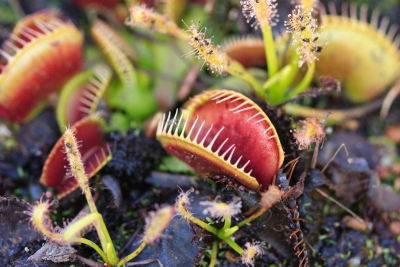
The Venus fly trap closes, traps, then digests any insect that lands on its haircovered leaves.
The pitcher plant captures insects that venture over the rim then fall to the bottom. A few plants grow large enough to trap small reptiles and animals. Some pitcher plants can open their lids and let rainwater in to drown their prey.
Venus flytraps tend to live in nutrient-poor soil, which is why they rely on insects to help them survive. Ants, beetles, grasshoppers, flying insects, and even spiders are on the menu!
Let’s delve a bit deeper into how the plant traps insects. It starts with the plant releasing a large number of volatile and fragrant organic compounds into the air that are attractive to insects. The hypothesis is that these volatile compounds may be the initial source of attraction and serve to bring the insects closer to the plant. Once the bugs approach one of the plant’s traps found at the end of each leaf, they are lured inside by a sweet-smelling, fragrant nectar secreted by the traps. The inside of the traps is covered with a red pigment that may also play a role in inviting insects into the deadly chamber.
When an insect enters, sensory hairs are disturbed and an electrical signal known as an action potential is triggered. If two or more such signals occur in a 20-30 second span, the trap clamps shut in less than a second although not completely. It takes even more action potentials caused by the struggling prey deflecting more sensory hairs for complete entrapment. The closure is helped by the detection of insect secretions such as uric acid, potassium ions, and sodium ions. This additional step ensures that it is an insect or arachnid, rather than some inanimate substance such as a raindrop or a seed that is stuck in the trap.
After the plant has detected that it has indeed captured a living prey, specialized glands are activated and begin to release a mixture of acidic digestive juices to decompose the victim into compounds that are useful to the plant. Chemicals containing nitrogen, phosphorous, and sulfur, essential for the plant’s growth, become available to supplement the nutrients available from the soil.
Once a Venus flytrap has closed, it remains shut for 5 to 12 days while it digests its prey. When done, only the insect’s exoskeleton remains. The trap opens, the exoskeleton is expelled and the Venus flytrap is ready for its next meal.
Credit : McGill
Picture Credit : Google




